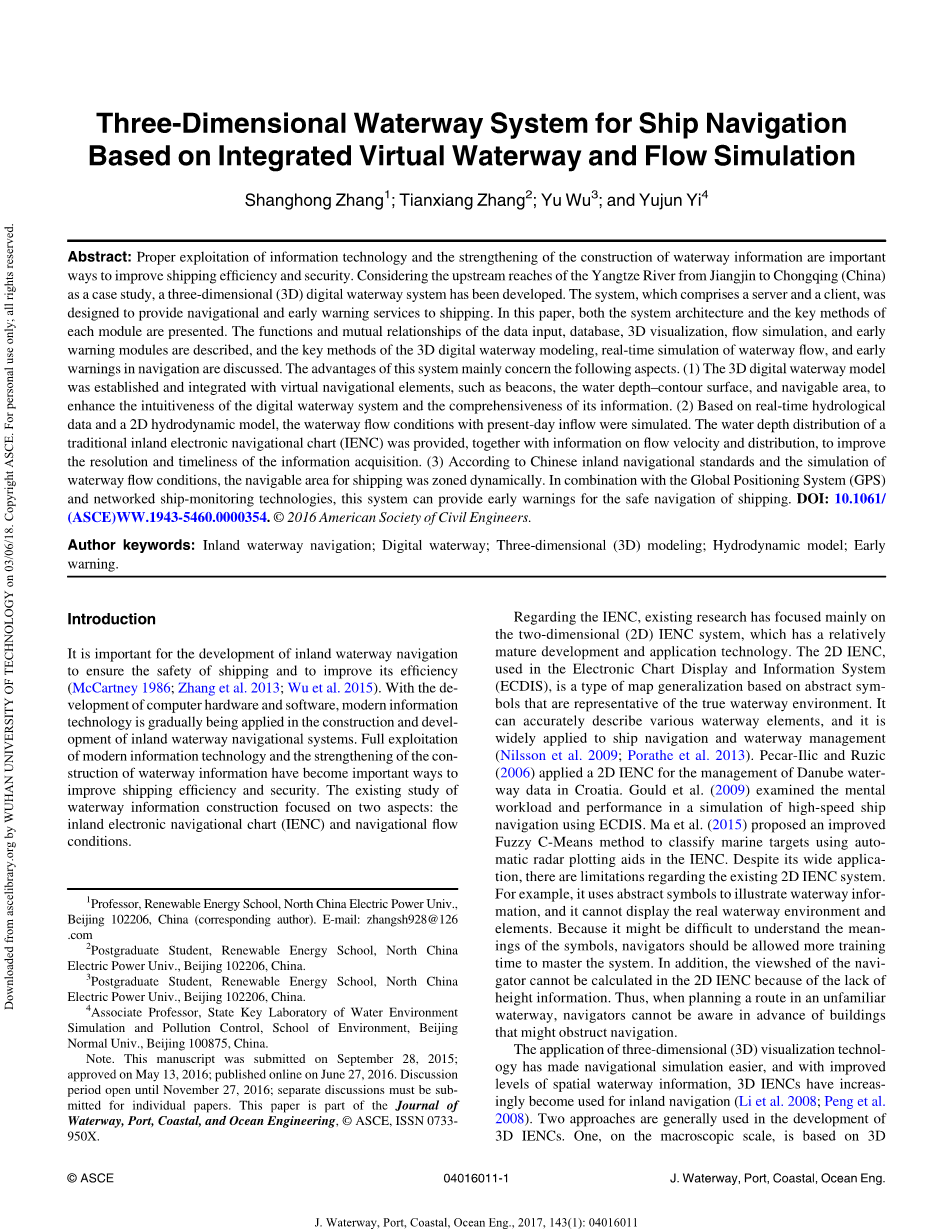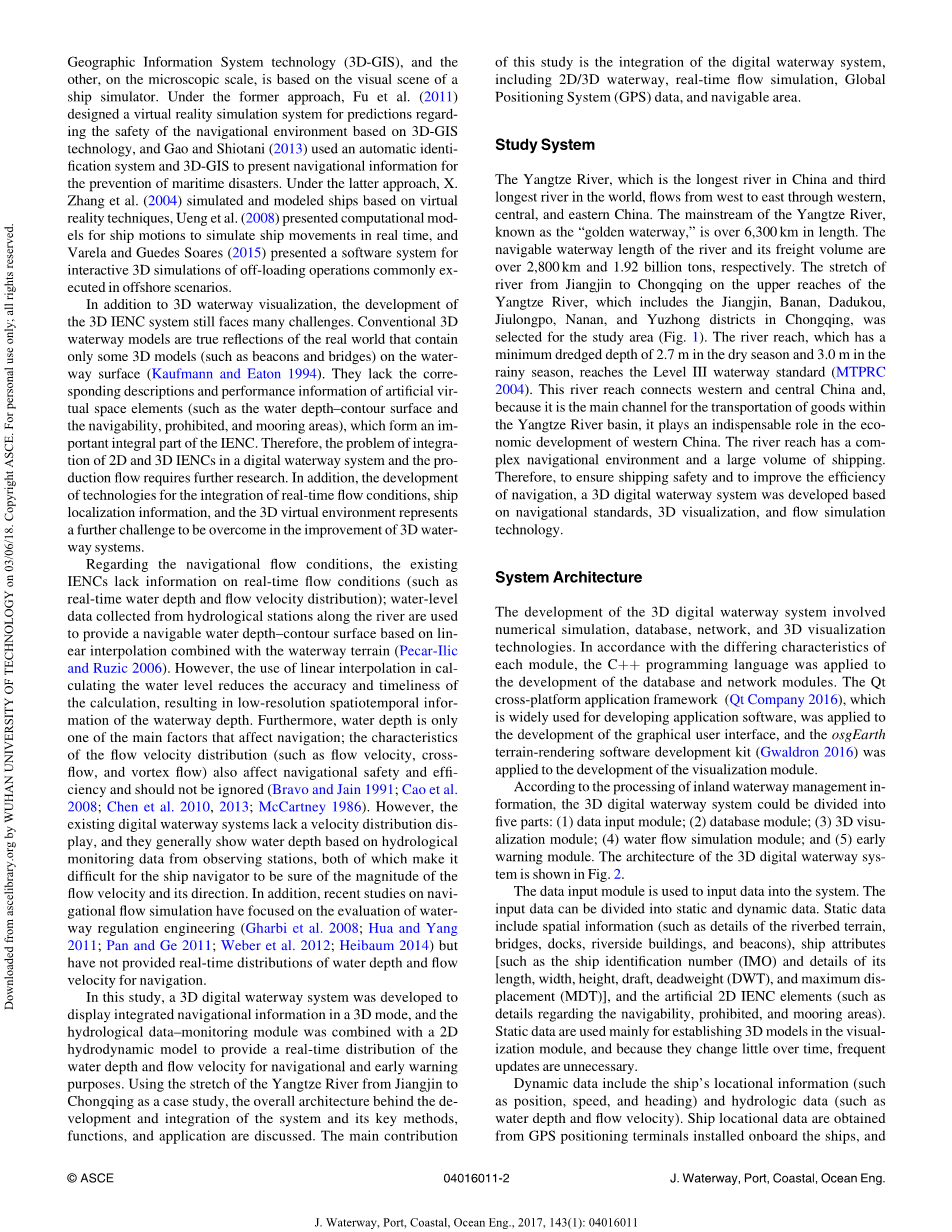

英语原文共 14 页,剩余内容已隐藏,支付完成后下载完整资料
Three-Dimensional Waterway System for Ship Navigation Based on Integrated Virtual Waterway and Flow Simulation
基于综合虚拟航道和水流模拟的船舶航行三维航道系统
Abstract摘要
Proper exploitation of information technology and the strengthening of the construction of waterway information are important ways to improve shipping efficiency and security. Considering the upstream reaches of the Yangtze River from Jiangjin to Chongqing (China) as a case study, a three-dimensional (3D) digital waterway system has been developed. The system, which comprises a server and a client, was designed to provide navigational and early warning services to shipping. In this paper, both the system architecture and the key methods of each module are presented. The functions and mutual relationships of the data input, database, 3D visualization, flow simulation, and early warning modules are described, and the key methods of the 3D digital waterway modeling, real-time simulation of waterway flow, and early warnings in navigation are discussed. The advantages of this system mainly concern the following aspects. (1) The 3D digital waterway model was established and integrated with virtual navigational elements, such as beacons, the water depth–contour surface, and navigable area, to enhance the intuitiveness of the digital waterway system and the comprehensiveness of its information. (2) Based on real-time hydrological data and a 2D hydrodynamic model, the waterway flow conditions with present-day inflow were simulated. The water depth distribution of a traditional inland electronic navigational chart (IENC) was provided, together with information on flow velocity and distribution, to improve the resolution and timeliness of the information acquisition. (3) According to Chinese inland navigational standards and the simulation of waterway flow conditions, the navigable area for shipping was zoned dynamically. In combination with the Global Positioning System (GPS) and networked ship-monitoring technologies, this system can provide early warnings for the safe navigation of shipping.
信息技术的合理利用和加强航道信息的建设是提高航运效率和安全的重要途径。摘要从江津到重庆(中国)的上游河段,开发了一个三维(三维)数字航道系统。该系统由一个服务器和一个客户端组成,旨在为航运提供导航和早期预警服务。本文阐述了系统结构和各模块的关键方法。介绍了数据输入、数据库、三维可视化、流程仿真和预警模块的功能和相互关系,并讨论了三维数字航道建模的关键方法、航道实时仿真和导航早期预警。该系统的优点主要涉及以下几个方面。(1)建立三维数字航道模型,结合航标、水深等值面、通航区域等虚拟导航要素,增强数字航道系统的直观和信息的全面性。(2)根据实时水文数据和二维流体动力学模型,模拟了水流的流动条件。传统的内陆的水深分布电子导航图(IENC)提供,连同信息流速分布,提高分辨率和信息采集的及时性。(3)根据中国内地的航行标准和航道条件的模拟,船舶的通航区域是动态分区的。该系统与全球定位系统(GPS)和网络化的船舶监控技术相结合,可以为船舶的安全导航提供早期预警。
Key Methods主要方法
Digital Waterway Modeling数字航道建模
3D Waterway Modeling三维航道建模
To implement the 3D visualization of the waterway, 3D digital waterway modeling was a necessary requirement. Based on real data, the 3D digital waterway modeling integrates a regional image with details of terrain and buildings to implement the 3D digital waterway construction. This then displays the virtual scene, which includes the river terrain, docks, bridges, ships, beacons, and riverside buildings, directly in the computer. However, because of the large volume of waterway terrain and image data, loading the entire channel image or all the terrain data directly into the 3D visualization module would impose a considerable rendering burden, which would make virtual roaming and real-time data interaction impractical. To accelerate the speed of data loading, the 3D digital waterway modeling can be divided into in-waterway modeling and out-waterway modeling, according to the necessary modeling precision.
为了实现水道的三维可视化,三维数字水道建模是一个必要的要求。在真实数据的基础上,三维数字航道建模将区域图像与地形、建筑细节相结合,实现三维数字航道建设。然后显示虚拟场景,包括河流地形、码头、桥梁、船只、信标和河边建筑物,直接在计算机中。然而,由于水路地形和图像数据量大,将整个信道图像或所有地形数据直接加载到三维可视化模块中,会带来相当大的渲染负担,这将使虚拟漫游和实时数据交互变得不切实际。为了加快数据加载速度,根据必要的建模精度,将三维数字航道建模分为航道建模和外航道建模。
The in-waterway modeling constitutes the main content of the 3D digital waterway modeling. The models in the waterway consist of the riverbed terrain, bridges, docks, beacons, and ships. Riverbed terrain modeling is performed based on elevation and image data. This uses 2.5-m resolution data of the riverbed terrain, obtained by the Chinese Waterway Management Department instead of from satellites (Hostache et al. 2015), from which a digital elevation network is built in the 3D virtual space to simulate the real riverbed terrain. Then, the real texture map, derived from riverbed image data, is textured onto the surface of the riverbed terrain model to provide a more intuitive expression of the waterway flow images.
航道建模是三维数字航道建模的主要内容。水道中的模型包括河床地形、桥梁、码头、信标和船舶。基于高程和图像数据进行河床地形建模。这是由中国水路管理部门而非卫星(Hostache 等人 2015)所获得的河床地形的2.5 m分辨率数据,在三维虚拟空间中建立了数字高程网络,模拟真实的河床地形。然后,从河床图像数据中提取出真实的纹理贴图,纹理贴图到河床地形模型的表面,从而提供更直观的水道流图像表达。
The bridges, docks, beacons, and ships represent the core elements of the 3D digital waterway system. The models of these elements are intended to retain as much detail as possible to remain vivid in their appearance. Therefore, some 3D modeling tools (such as MultiGen Creator, AutoCAD, 3D MAX, and Maya) were adopted to create the fine structure and material characteristics of these models.
桥梁、码头、信标和船舶是三维数字航道系统的核心要素。这些元素的模型旨在保留尽可能多的细节,以保持其形象的生动形象。因此,一些3D建模工具(如MultiGen Creator、AutoCAD、3D MAX和Maya)被用来创建这些模型的精细结构和材料特性。
The out-waterway modeling is used mainly to create the virtual environment around the waterway as an effective supplement to the waterway modeling. Because the external environment of the waterway has no direct influence on ship navigation and
全文共35822字,剩余内容已隐藏,支付完成后下载完整资料
资料编号:[9530],资料为PDF文档或Word文档,PDF文档可免费转换为Word


